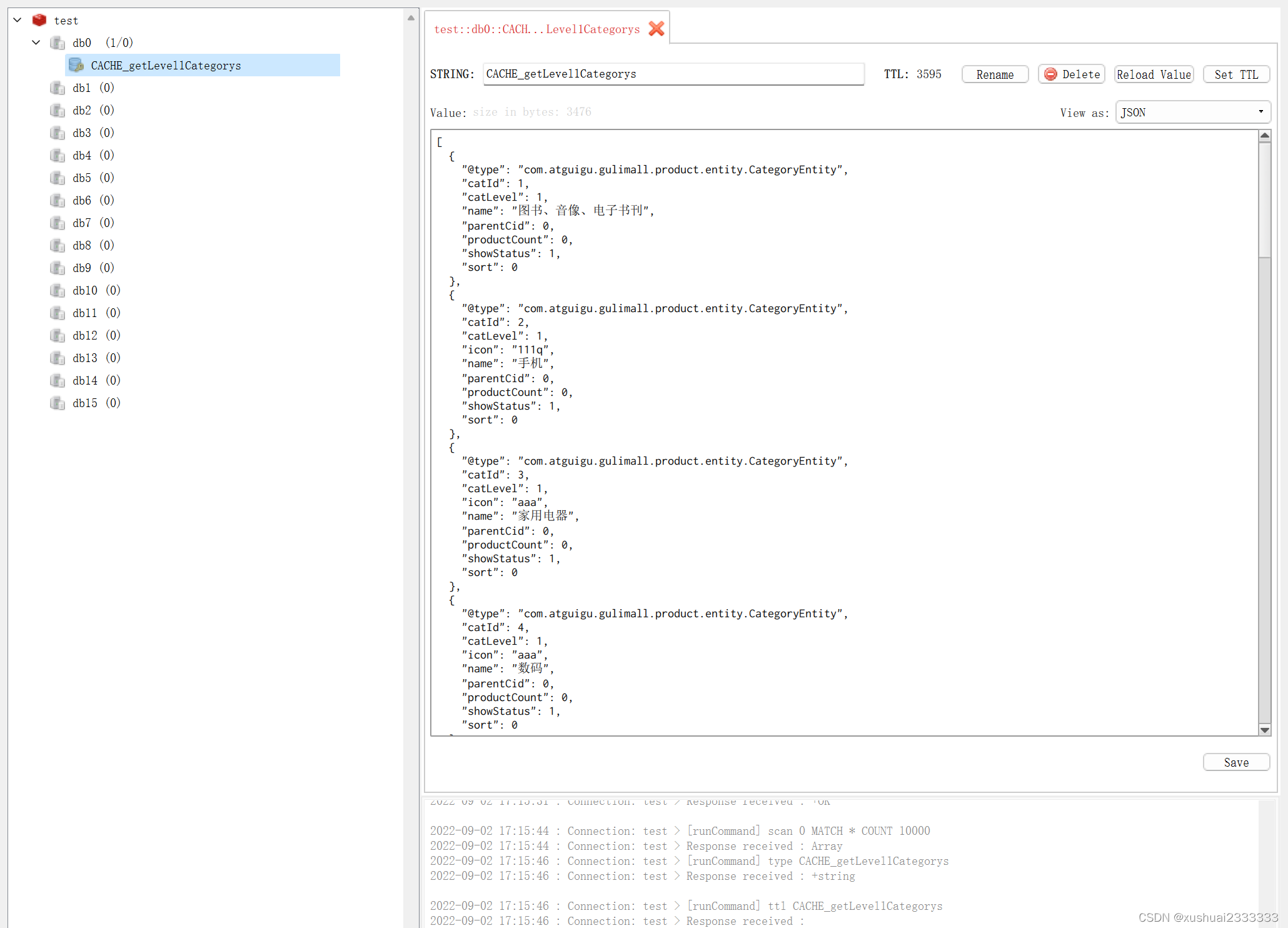Spring Cache和redis结合使用
Spring Cache和redis结合使用
<dependency>
<groupId>org.springframework.boot</groupId>
<artifactId>spring-boot-starter-cache</artifactId>
</dependency>
<dependency>
<groupId>org.springframework.boot</groupId>
<artifactId>spring-boot-starter-data-redis</artifactId>
</dependency>2.2配置文件application.properties
#名字可以自动配置
#spring.cache.cache-names=qq
spring.cache.type=redis
#设定数据存活时间1小时
spring.cache.redis.time-to-live=3600000
#key的前缀
spring.cache.redis.key-prefix=CACHE_
#key是否用前缀
spring.cache.redis.use-key-prefix=false
#是否缓存空值,防止缓存穿透
spring.cache.redis.cache-null-values=true2.3自行配置RedisCacheConfiguration(如果不配置需要将@EnableCaching放到启动类上)
package com.atguigu.gulimall.product.config;
import com.alibaba.fastjson.support.spring.GenericFastJsonRedisSerializer;
import org.springframework.boot.autoconfigure.cache.CacheProperties;
import org.springframework.boot.context.properties.EnableConfigurationProperties;
import org.springframework.cache.annotation.EnableCaching;
import org.springframework.context.annotation.Bean;
import org.springframework.context.annotation.Configuration;
import org.springframework.data.redis.cache.RedisCacheConfiguration;
import org.springframework.data.redis.serializer.RedisSerializationContext;
import org.springframework.data.redis.serializer.StringRedisSerializer;
@EnableConfigurationProperties(CacheProperties.class)
@Configuration
@EnableCaching
public class MyCacheConfig {
@Bean
RedisCacheConfiguration redisCacheConfiguration(CacheProperties cacheProperties){
RedisCacheConfiguration config = RedisCacheConfiguration.defaultCacheConfig();
//设置key用string类型保存,value用json格式保存
config = config.serializeKeysWith(RedisSerializationContext.SerializationPair.fromSerializer(new StringRedisSerializer()));
config = config.serializeValuesWith(RedisSerializationContext.SerializationPair.fromSerializer(new GenericFastJsonRedisSerializer()));
CacheProperties.Redis redisProperties = cacheProperties.getRedis();
//使配置文件中所有的配置都生效
if (redisProperties.getTimeToLive() != null) {
config = config.entryTtl(redisProperties.getTimeToLive());
}
if (redisProperties.getKeyPrefix() != null) {
config = config.prefixKeysWith(redisProperties.getKeyPrefix());
}
if (!redisProperties.isCacheNullValues()) {
config = config.disableCachingNullValues();
}
if (!redisProperties.isUseKeyPrefix()) {
config = config.disableKeyPrefix();
}
return config;
}
}
2.4使用注解操作
/**
* 每一个需要缓存的数据都要指定要放到哪个名字的缓存。【缓存的分区(按照业务类型分)】
* 代表当前方法的结果需要缓存,如果缓存中有,方法不会调用,如果缓存中没有,会调用方法。并将方法的结果放入缓存
* 默认行为
* 1)如果缓存中有,方法不再调用
* 2)key是默认生成的:缓存的名字::SimpleKey::[](自动生成key值)
* 3)缓存的value值,默认使用jdk序列化机制,将序列化的数据存到redis中
* 4)默认ttl时间是 -1:
*
* 用户自行操作:key的生成
* 1)指定生成缓存的key:key属性可以指定,接收一个Spel
* 2)指定缓存的数据的存活时间:配置文档中修改存活时间
* 3)将数据保存为json格式
* CacheAutoConfiguration->RedisCacheConfiguration->自动配置了RedisCacheManager->初始化所有的缓存
* -》每个缓存决定使用什么配置->如果redisCacheConfiguration有就用已有的,没有就用默认的配置->想改缓存配置,只需给容器
* 中放一个RedisCacheConfiguration即可->就会应用到当前RedisCacheManager管理的所有缓存分区中
*
*/
@Cacheable(value={"category"},key="#root.method.name",sync = true)
@Override
public List<CategoryEntity> getLevel1Categorys() {
return this.baseMapper.selectList(new QueryWrapper<CategoryEntity>().eq("parent_cid",0));
}2.5访问redis数据库

2.6再添加两个方法
@Cacheable(value = "category",key="#root.methodName")
@Override
public Map<String, List<Catelog2Vo>> getCatelogJson() {
//业务操作。。。
} //多项操作时用@Caching
@Caching(evict = {
@CacheEvict(value = "category",key="'getLevelCategorys'"),
@CacheEvict(value = "category",key="'getCatelogJson'")
})
@Transactional
@Override
public void updateCascade(CategoryEntity category) {
this.updateById(category);
System.out.println(category.getCatId());
System.out.println(category.getName());
categoryBrandRelationService.updateCatelog(category.getCatId(),category.getName());
}2.7运行测试
先执行getLevel1Categorys()和getCatelogJson()两个方法,可以看到redis数据库里存了它们缓存的数据

接着运行 updateCascade()方法,则数据消失了。@Caching可同时进行多项操作,@CacheEvict可以删除指定的缓存。
补充:将
@Caching(evict = {
@CacheEvict(value = "category",key="'getLevelCategorys'"),
@CacheEvict(value = "category",key="'getCatelogJson'")
})
替换成
@CacheEvict(value = "category",allEntries = true) //删除某个分区下的所有数据
可以获得同样的效果。
同时,将配置文件替换成:
#名字可以自动配置
#spring.cache.cache-names=qq
spring.cache.type=redis
#设定数据存活时间1小时
spring.cache.redis.time-to-live=3600000
#key的前缀
#spring.cache.redis.key-prefix=CACHE_
#key是否用前缀
spring.cache.redis.use-key-prefix=true
#是否缓存空值,防止缓存穿透
spring.cache.redis.cache-null-values=true执行执行getLevel1Categorys()和getCatelogJson()两个方法,可以看到数据库里两个缓存数据归类到category下面:

3、SpringCache的不足之处
1)、读模式
缓存穿透:查询一个null数据。解决方案:缓存空数据。
spring.cache.redis.cache-null-values=true缓存击穿:大量并发进来同时查询一个正好过期的数据。解决方案:加锁 ? 默认是无加锁的;使用sync = true来解决击穿问题。
@Cacheable(value={"category"},key="#root.method.name",sync = true)缓存雪崩:大量的key同时过期。解决:加随机时间。加上过期时间。
spring.cache.redis.time-to-live=36000002)、写模式:(缓存与数据库一致)
读写加锁。
引入Canal,感知到MySQL的更新去更新Redis
读多写多,直接去数据库查询就行
4、总结
常规数据(读多写少,即时性,一致性要求不高的数据,完全可以使用Spring-Cache):写模式(只要缓存的数据有过期时间就足够了)
原理:CacheManager(RedisCacheManager)->Cache(RedisCache)->Cache负责缓存的读写
更多推荐
 已为社区贡献1条内容
已为社区贡献1条内容









所有评论(0)